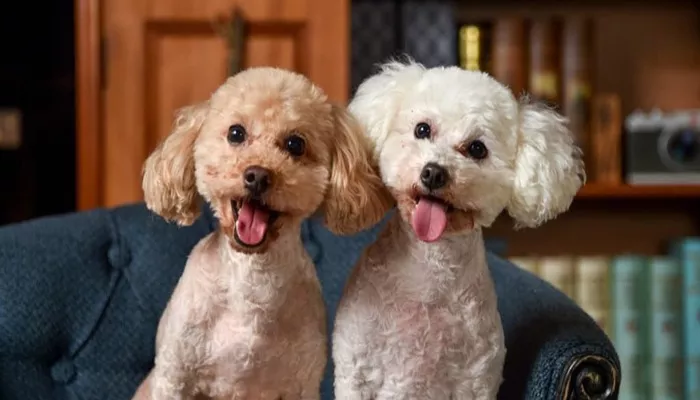The Bichon Frise and the Poodle are two popular dog breeds often mistaken for each other due to their fluffy coats and charming appearances. However, these breeds are distinct in origin, physical traits, and temperament. This article explores their differences and similarities, addressing the common confusion: Is the Bichon Frise a type of Poodle?
Origins and History
Bichon Frise: A Mediterranean Companion
The Bichon Frise originated in the Mediterranean region, with roots tracing back to the 15th century. Its ancestors include the Barbet (a water spaniel) and small white lapdogs from the Canary Islands. Historically, these dogs were favored by European nobility, including French royalty, and were later popularized as circus performers due to their playful nature.
Poodle: A Versatile European Breed
The Poodle, often called the “Pudel” (meaning “splash in water” in German), has a more complex history. Originating as a water retriever in Germany and France, it was bred for hunting and later became a symbol of luxury among European aristocrats. Poodles come in four sizes: Standard, Miniature, Toy, and Medium (recognized in some regions)29.
Key Difference
While both breeds have European roots, the Bichon Frise was developed as a companion dog, whereas the Poodle was initially a working retriever.
Physical Characteristics
Coat and Color
Bichon Frise: Known for its soft, curly, double-layered coat that is always pure white. The texture resembles plush velvet, requiring frequent grooming to prevent matting.
Poodle: Features a dense, curly single coat that can be clipped into various styles. Poodles come in multiple colors, including black, white, apricot, and gray.
Size and Structure
Bichon Frise: A small breed, standing 9.5–11.5 inches tall and weighing 7–12 pounds. Its body is slightly longer than tall, giving it a rectangular shape.
Poodle: Varies by type. For example, the Toy Poodle stands under 10 inches, while the Standard Poodle can reach over 15 inches. Poodles have a square, balanced build.
Key Difference: The Bichon’s coat is exclusively white and softer, while Poodles exhibit color variety and a more structured, curly coat.
Temperament and Intelligence
Bichon Frise: The Social Butterfly
Bichons are affectionate, playful, and thrive on human interaction. They are known for their cheerful demeanor and adaptability to apartment living. However, they may develop separation anxiety if left alone for long periods.
Poodle: The Brainy Performer
Poodles rank as the second-most intelligent dog breed (after Border Collies). They are highly trainable, energetic, and excel in obedience and agility sports. Their alertness makes them excellent watchdogs.
Key Difference
Poodles are more independent and task-oriented, while Bichons prioritize social bonding.
Grooming and Maintenance
Bichon Frise: High-Maintenance Fluff
Their hypoallergenic coat requires daily brushing and professional grooming every 4–6 weeks to maintain its signature “powder puff” look. Regular ear cleaning is also essential due to their floppy ears.
Poodle: Versatile Styling Options
Poodles need weekly brushing and frequent trims. Their low-shedding coat is ideal for allergy sufferers. Popular cuts include the “puppy clip” and the show-standard “Continental clip”.
Key Difference
Bichons demand more consistent grooming to avoid tangles, while Poodles offer styling flexibility.
Common Misconceptions
Myth 1: “Bichons Are White Poodles”
This confusion arises from their similar coats. However, Bichons have a distinct lineage and cannot be classified as Poodle variants.
Myth 2: “All Small, Curly Dogs Are Poodles”
Breeds like the Maltese, Coton de Tulear, and Bichon Frise share visual traits with Poodles but belong to separate genetic groups.
The “Teddy Bear” Mislabel
The term “Teddy Bear” often refers to Poodles with a specific haircut, not the Bichon. Bichons are occasionally mislabeled as “white Teddies,” but this is incorrect.
Why the Confusion Persists
Similar Aesthetics: Both breeds have curly, hypoallergenic coats and compact sizes.
Popular Crossbreeds: Hybrids like the “Bichpoo” (Bichon + Poodle) blend traits from both breeds, further muddying distinctions.
Grooming Styles: A Bichon trimmed in a “Poodle-like” clip can appear nearly identical to a Toy Poodle.
Conclusion
The Bichon Frise and Poodle are separate breeds with unique histories, physical traits, and personalities. While they share superficial similarities, their genetic backgrounds and roles—companion vs. working dog—set them apart. Understanding these differences helps owners provide appropriate care and appreciate each breed’s distinct charm.
Related Topics:
HOW OFTEN DOES A BICHON FRISE NEED TO BE WALKED?
IS A MALE OR FEMALE BICHON FRISE BETTER?
AT WHAT AGE IS A BICHON FRISE FULL GROWN?


